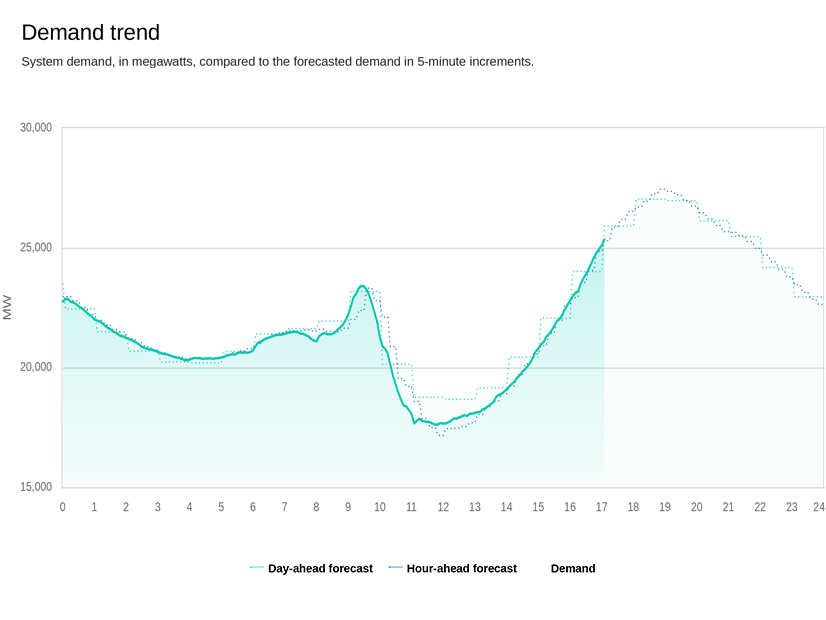
CAISO maintained normal grid operations during Saturday morning’s solar eclipse, with swings in solar production that were more muted than what the ISO had modeled based on clear-sky conditions.
As the moon obscured much of the sun throughout California and other Western states, solar production in CAISO’s territory dropped to 3,434 MW at 9:30 a.m. PST, following an early morning peak of around 8,100 MW shortly before 9 a.m. That’s a drop of 4,666 MW.
As expected, net demand in the ISO spiked at 9:30 a.m. as both utility-scale and behind-the-meter rooftop solar dropped off. Still, demand of 24,023 MW at 9:30 a.m. was well within the 44,756 MW of available capacity at that time. Energy supplies from natural gas and imports increased between 8:30 a.m. and 9 a.m. as solar output fell.
After bottoming out at 9:30 a.m., solar output quickly climbed to nearly 11,000 MW around 11 a.m. The eclipse lasted from about 8 a.m. to 11 a.m.
The eclipse-day figures are from CAISO’s daily outlook data posted to its website on Saturday.
“The power grid remained stable throughout the duration of the eclipse, and system operations returned to normal shortly after the conclusion at 11:05 a.m,” CAISO spokesperson Anne Gonzalez told RTO Insider in an email Monday. “Overall, generators followed their forecasted dispatches closely, and ramping was smooth heading in and out of the eclipse.”
The ISO plans to release a full analysis of eclipse operations in December, she said.
In modeling of eclipse impacts ahead of the Oct. 14 event, CAISO had forecast a dip in solar production to 3,240 MW at 9:30 a.m., with a rapid ramp up to 14,041 MW at 11 a.m.
In a technical bulletin released in August regarding the Oct. 14 eclipse, CAISO identified that ramping period as a time of “operational interest” that it would study “to ensure adequate supplies of generation [reserves] are available to mitigate any adverse effects of the anticipated steep up-ramp in solar production.” (See CAISO Sheds Light on October Solar Eclipse Preparations.)
The swings in solar production seen on Saturday were less intense than what CAISO had modeled. CAISO had estimated a ramp-up rate of 120 MW per minute between 9:30 and 11 a.m. The actual rate was roughly 84 MW per minute.
CAISO’s modeling was based on a day with clear skies, when the drop-off and return of solar would be most marked. The ISO noted the modeling was a “high impact” scenario, and that cloudy skies on Oct. 14 would lessen the impact.
Saturday’s weather conditions included cloudy conditions in parts of California.
The Oct. 14 event was a partial — or annular — eclipse, in which the sun was obscured by 65% to 90% within the Western Energy Imbalance Market territory.
In its technical bulletin, CAISO contrasted Saturday’s event with the total eclipse on Aug. 21, 2017.
Since 2017, grid-scale solar within the CAISO footprint has increased from 10,000 MW to 16,500 MW, and behind-the-meter solar has grown from 5,700 MW to 14,350 MW. That raised concerns that this year’s eclipse might have greater impacts than the 2017 event.
On the other hand, because the Oct. 14 eclipse fell on a Saturday, demand was expected to be less than it would have been on a weekday. The 2017 eclipse was on a Monday morning.
